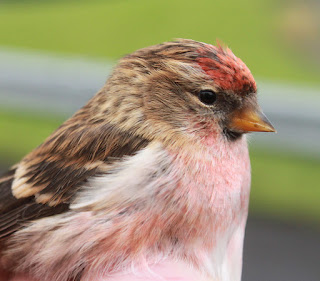It’s official. The month of December 2015 was the wettest month ever in the UK since records began. But we’ve turned the corner, climbed the mountain and reached the end of the long, dark tunnel and everything is hunky-dory - for now. The daylight hours are already noticeably longer and at home in the garden there are Mistle Thrushes, Great Tits, Coal Tits and Nuthatches in song. Spring is within sight.
And at last the weather relented enough to allow Andy and I to plan our first ringing session of 2016 at Oakenclough. After a few weeks of inaction the old pliers needed a dollop of WD40.
Oiling The Joints
We met up at 0815 and set just a couple of nets. By midday we had caught 51 birds - 36 new ones and 15 recaptures of five species only.
Catching was steady but not spectacular with new birds comprising 17 Goldfinch, 8 Chaffinch, 6 Blue Tit, 3 Great Tit and 2 Coal Tit.
The 15 recaptures from 2014/2015 proved to be 8 Coal Tit and 6 Blue Tit plus one other Blue Tit not of our ringing.
It’s soon into the New Year that we hope to catch Chaffinches that may be of the “Continental” type, individuals that are typically bigger and brighter than our UK ones. One of today’s first winter males was noticeably “chunky”, not overweight but with a wing length of 91mm a potential visitor from Europe.
Chaffinch
Our seventeen Goldfinches did not include any recaptures, suggesting that there is still in midwinter a good turnover of birds using the site.
Goldfinch
A Blue Tit beginning Z625 was not one of our own ring sequences but had been ringed elsewhere and we will find its origins in due course. Blue Tits are a generally sedentary species and other than us the nearest ringer is a good number of miles from Oakenclough.
Blue Tit
Andy and I recommenced ringing here at Oakenclough in late 2014 with the aim of monitoring the species using the site following the landowner’s programme of rhododendron clearance and replanting with native trees.
I just looked at the ringing totals for here during 2015 and found that of the 802 new birds caught the most ringed species was Chaffinch at 132. This was closely followed by the ubiquitous Blue Tit with 93 and then not far behind came Goldfinch, Goldcrest and Lesser Redpoll at 92, 81 and 70 respectively. Bonus species came in the shape of Pied Flycatchers and Tree Pipits together with a couple each of Bullfinch and Sparrowhawk to enliven the days. We had a healthy total of 61 Redwings and a handful of Fieldfares and probably more to come until the weather put paid to our activities in November.
Sparrowhawk
All in all a very successful year. We hope to improve on that work during 2016, in particular by targeting finches again.
Birds noted during today’s ringing session - 4 Mistle Thrush, one of which was in loud song. 2 Great-spotted Woodpecker, 1 Sparrowhawk, 40+ Wood Pigeon.
Linkin today with Anni's Blog and Eileen's Saturday.
Linkin today with Anni's Blog and Eileen's Saturday.

































































.jpg)












